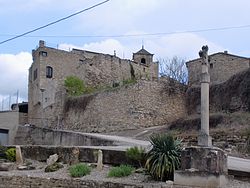Vallfogona de Riucorb
| Vallfogona de Riucorb | |||
|---|---|---|---|
| Municipality | |||

Vallfogona's castle and creu de terme (boundary cross)
|
|||
|
|||
| Coordinates: 41°33′48″N 1°14′11″E / 41.5633°N 1.2365°E | |||
| Country |
|
||
| Community |
|
||
| Province |
|
||
| Comarca |
|
||
| Government | |||
| • Mayor | Francesc Xavier Llobet Albareda (2015) | ||
| Area | |||
| • Total | 10.9 km2 (4.2 sq mi) | ||
| Elevation | 698 m (2,290 ft) | ||
| Population (2014) | |||
| • Total | 99 | ||
| • Density | 9.1/km2 (24/sq mi) | ||
| Demonym(s) | Vallfogoní | ||
| Website | www |
||
Vallfogona de Riucorb (Catalan pronunciation: [ˌbaʎfuˈɣonə ðə riwˈkɔrp]) is a municipality and village in the comarca of the Conca de Barberà in central Catalonia, Spain. It is situated in the Comalats range in the north of the comarca, with the Cap de Cans rising to 759 m. Vallfogona village is built on the south bank of the Corb river.
It is known for the medicinal mineral water that flows from a local spring, and for the priest and Baroque poet Francesc Vicent Garcia (1579-1623), "El Rector de Vallfogona." Garcia wrote mostly satirical verse, and was acquainted with notable authors of the time such as Lope de Vega. He ordered the construction of the chapel of Santa Bàrbara in 1617.
The first historical reference to Vallfogona records the founding of the parish in 1123 after its reconquest from the Moors, who had called it Vall d'Alfes. The town was a fief of the noble house of the Counts of Queralt. By 1150, the local lord, Gombau d'Oluja, had occupied the site of Vallfogona and had repopulated the area with Christian Catalans. He laid out the town, building a small castle and beginning construction on the town's Romanesque church, both of which still stand. On his death in 1191, Gombau ceded Vallfogona to the Knights Templar. When the Temple was suppressed in 1312, Vallfogona came under control of the Knights Hospitaller. In 1416 the Hospitallers reconstructed much of the church and castle.
Vallfogona's first tourist facility, the Fonda Dolores, opened in 1870 to serve visitors to the spring and its medicinal waters.
During the Spanish Civil War (1936–39), the hotels at the spa served as a hospital for wounded Republican soldiers. About 100 casualties were buried in a mass grave in the cemetery. Three men, all conservatives, were shot by leftist forces at the beginning of the conflict. Eleven soldiers from Vallfogona died in the fighting, all on the Republican side. The Francoist victors did not execute any Vallfogonins, but at least five of them were imprisoned and several had to flee to France. Vallfogona lost nearly 20% of its population.
...
Wikipedia



